EPS701 Module 5: Ethnographic Portrait of Burwood East Community
VerifiedAdded on 2023/04/03
|16
|3635
|221
Report
AI Summary
This ethnographic report provides a detailed portrait of Burwood East, a suburb in Melbourne, Victoria, Australia. The study examines the demographic makeup of the area, including its diverse ethnic groups such as the Chinese, British, Australian, and Greek communities, and highlights the presence of the Wurundjeri Aboriginal clan. The report delves into the social aspects of Burwood East, exploring community dynamics, the presence of educational institutions, and the cost of living in comparison to neighboring areas. It also addresses cultural aspects, including the celebration of Aboriginal culture and festivals. Furthermore, the report touches upon the economic and geographic aspects of Burwood East, offering a comprehensive understanding of the suburb's characteristics and its significance within the broader context of Melbourne. The report fulfills the assignment brief's requirements by providing a comprehensive ethnographic study of the specified community, highlighting the historical and contemporary aspects of its diverse population.
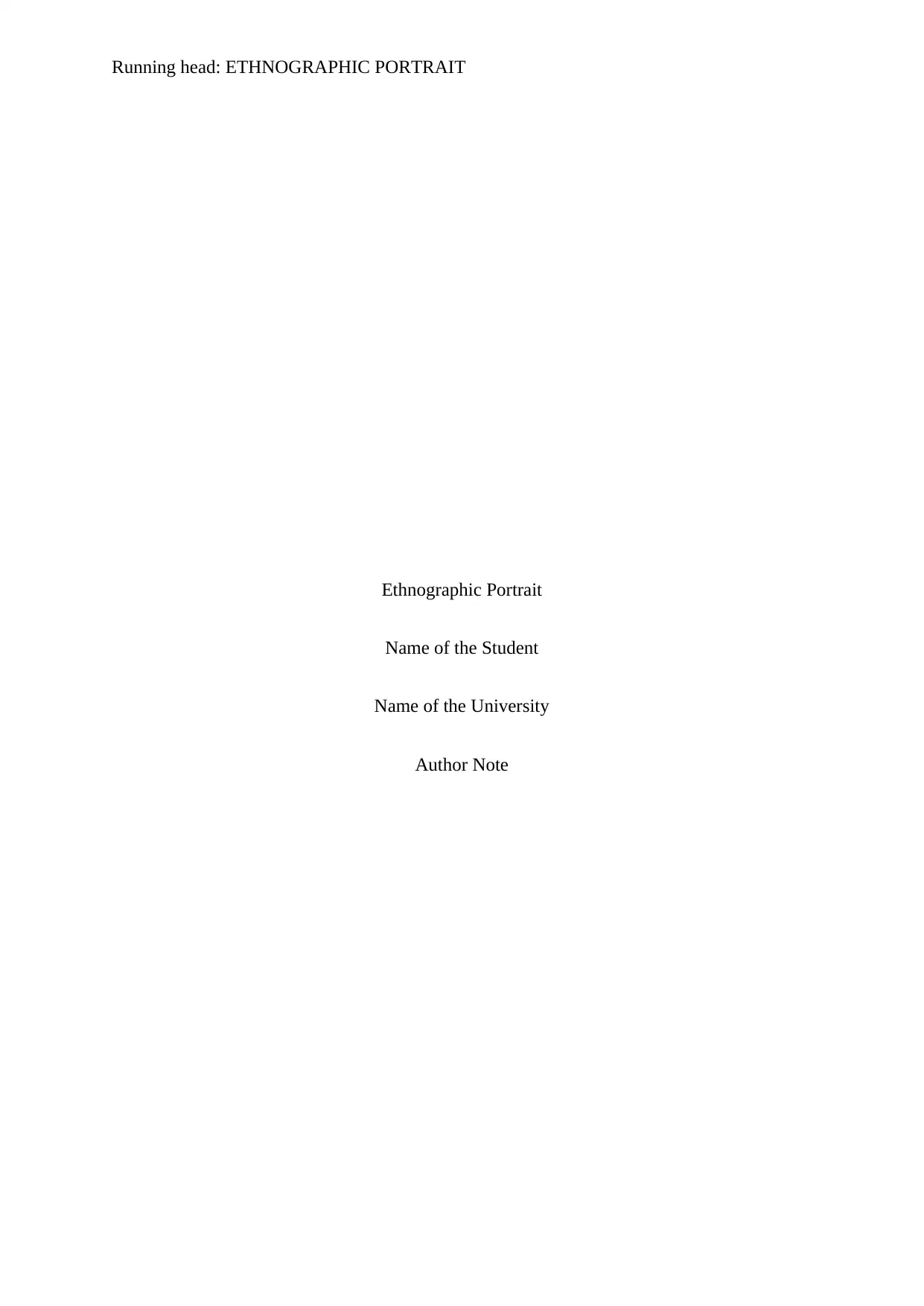
Running head: ETHNOGRAPHIC PORTRAIT
Ethnographic Portrait
Name of the Student
Name of the University
Author Note
Ethnographic Portrait
Name of the Student
Name of the University
Author Note
Paraphrase This Document
Need a fresh take? Get an instant paraphrase of this document with our AI Paraphraser
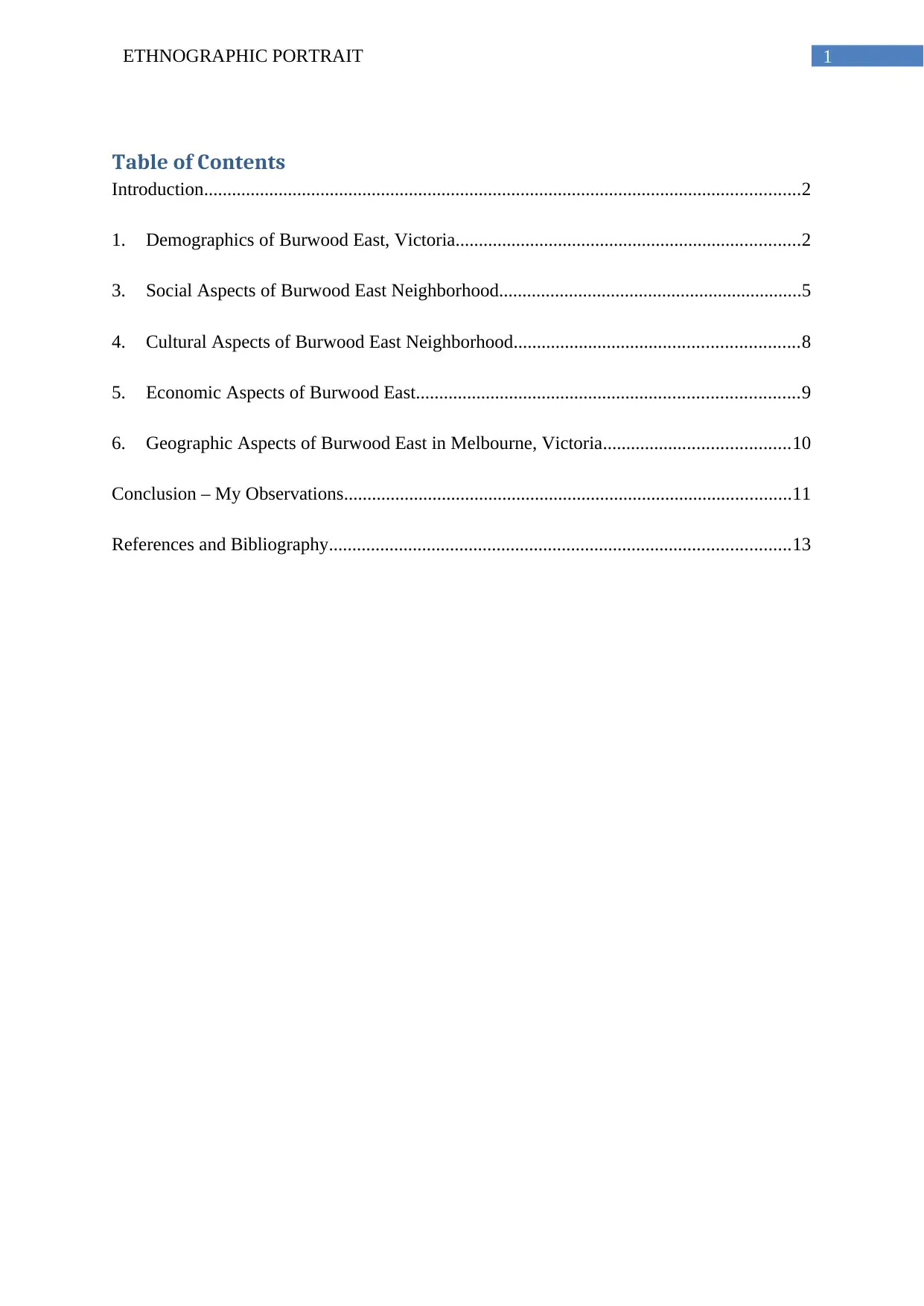
1ETHNOGRAPHIC PORTRAIT
Table of Contents
Introduction................................................................................................................................2
1. Demographics of Burwood East, Victoria..........................................................................2
3. Social Aspects of Burwood East Neighborhood.................................................................5
4. Cultural Aspects of Burwood East Neighborhood.............................................................8
5. Economic Aspects of Burwood East..................................................................................9
6. Geographic Aspects of Burwood East in Melbourne, Victoria........................................10
Conclusion – My Observations................................................................................................11
References and Bibliography...................................................................................................13
Table of Contents
Introduction................................................................................................................................2
1. Demographics of Burwood East, Victoria..........................................................................2
3. Social Aspects of Burwood East Neighborhood.................................................................5
4. Cultural Aspects of Burwood East Neighborhood.............................................................8
5. Economic Aspects of Burwood East..................................................................................9
6. Geographic Aspects of Burwood East in Melbourne, Victoria........................................10
Conclusion – My Observations................................................................................................11
References and Bibliography...................................................................................................13
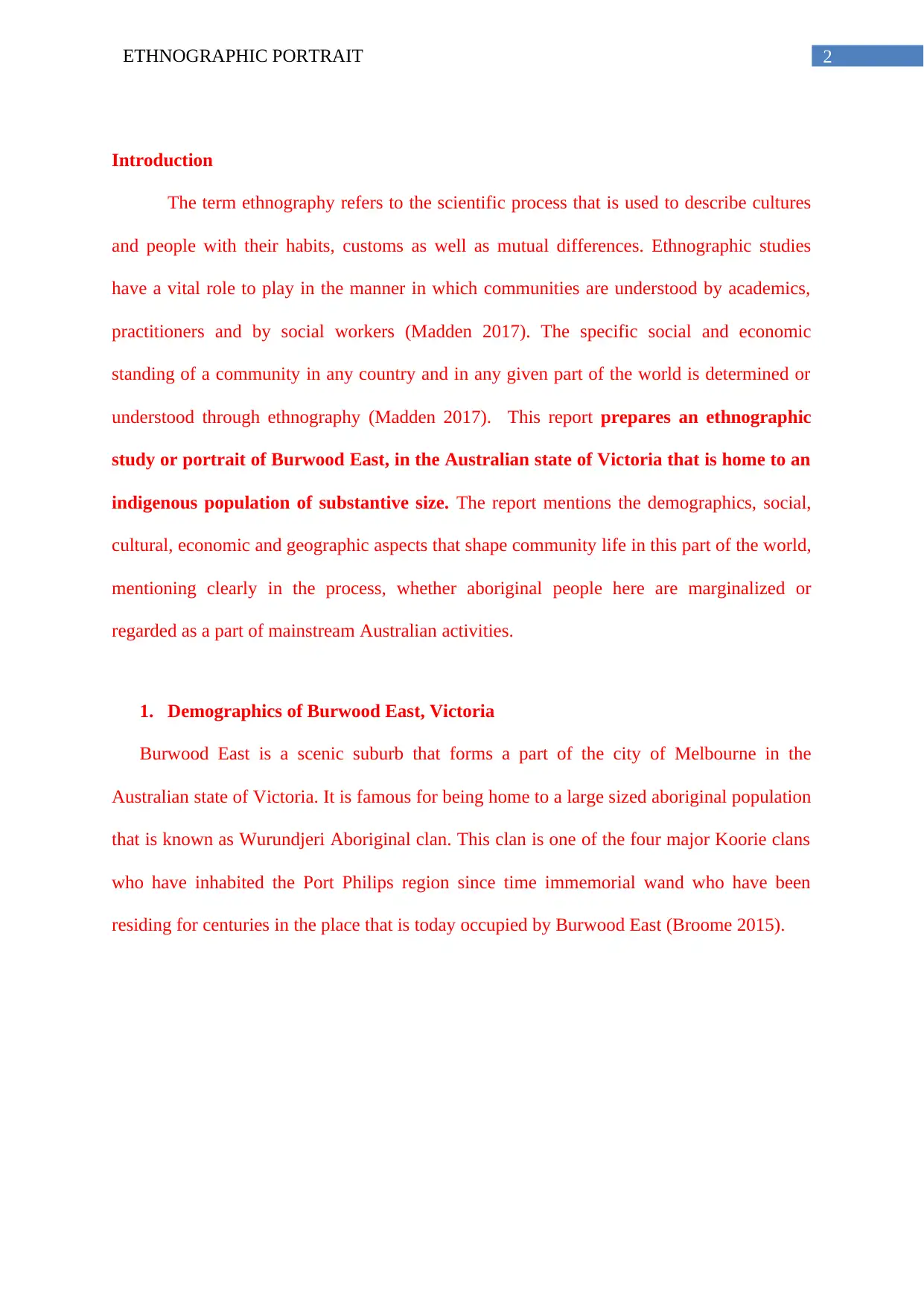
2ETHNOGRAPHIC PORTRAIT
Introduction
The term ethnography refers to the scientific process that is used to describe cultures
and people with their habits, customs as well as mutual differences. Ethnographic studies
have a vital role to play in the manner in which communities are understood by academics,
practitioners and by social workers (Madden 2017). The specific social and economic
standing of a community in any country and in any given part of the world is determined or
understood through ethnography (Madden 2017). This report prepares an ethnographic
study or portrait of Burwood East, in the Australian state of Victoria that is home to an
indigenous population of substantive size. The report mentions the demographics, social,
cultural, economic and geographic aspects that shape community life in this part of the world,
mentioning clearly in the process, whether aboriginal people here are marginalized or
regarded as a part of mainstream Australian activities.
1. Demographics of Burwood East, Victoria
Burwood East is a scenic suburb that forms a part of the city of Melbourne in the
Australian state of Victoria. It is famous for being home to a large sized aboriginal population
that is known as Wurundjeri Aboriginal clan. This clan is one of the four major Koorie clans
who have inhabited the Port Philips region since time immemorial wand who have been
residing for centuries in the place that is today occupied by Burwood East (Broome 2015).
Introduction
The term ethnography refers to the scientific process that is used to describe cultures
and people with their habits, customs as well as mutual differences. Ethnographic studies
have a vital role to play in the manner in which communities are understood by academics,
practitioners and by social workers (Madden 2017). The specific social and economic
standing of a community in any country and in any given part of the world is determined or
understood through ethnography (Madden 2017). This report prepares an ethnographic
study or portrait of Burwood East, in the Australian state of Victoria that is home to an
indigenous population of substantive size. The report mentions the demographics, social,
cultural, economic and geographic aspects that shape community life in this part of the world,
mentioning clearly in the process, whether aboriginal people here are marginalized or
regarded as a part of mainstream Australian activities.
1. Demographics of Burwood East, Victoria
Burwood East is a scenic suburb that forms a part of the city of Melbourne in the
Australian state of Victoria. It is famous for being home to a large sized aboriginal population
that is known as Wurundjeri Aboriginal clan. This clan is one of the four major Koorie clans
who have inhabited the Port Philips region since time immemorial wand who have been
residing for centuries in the place that is today occupied by Burwood East (Broome 2015).
⊘ This is a preview!⊘
Do you want full access?
Subscribe today to unlock all pages.

Trusted by 1+ million students worldwide
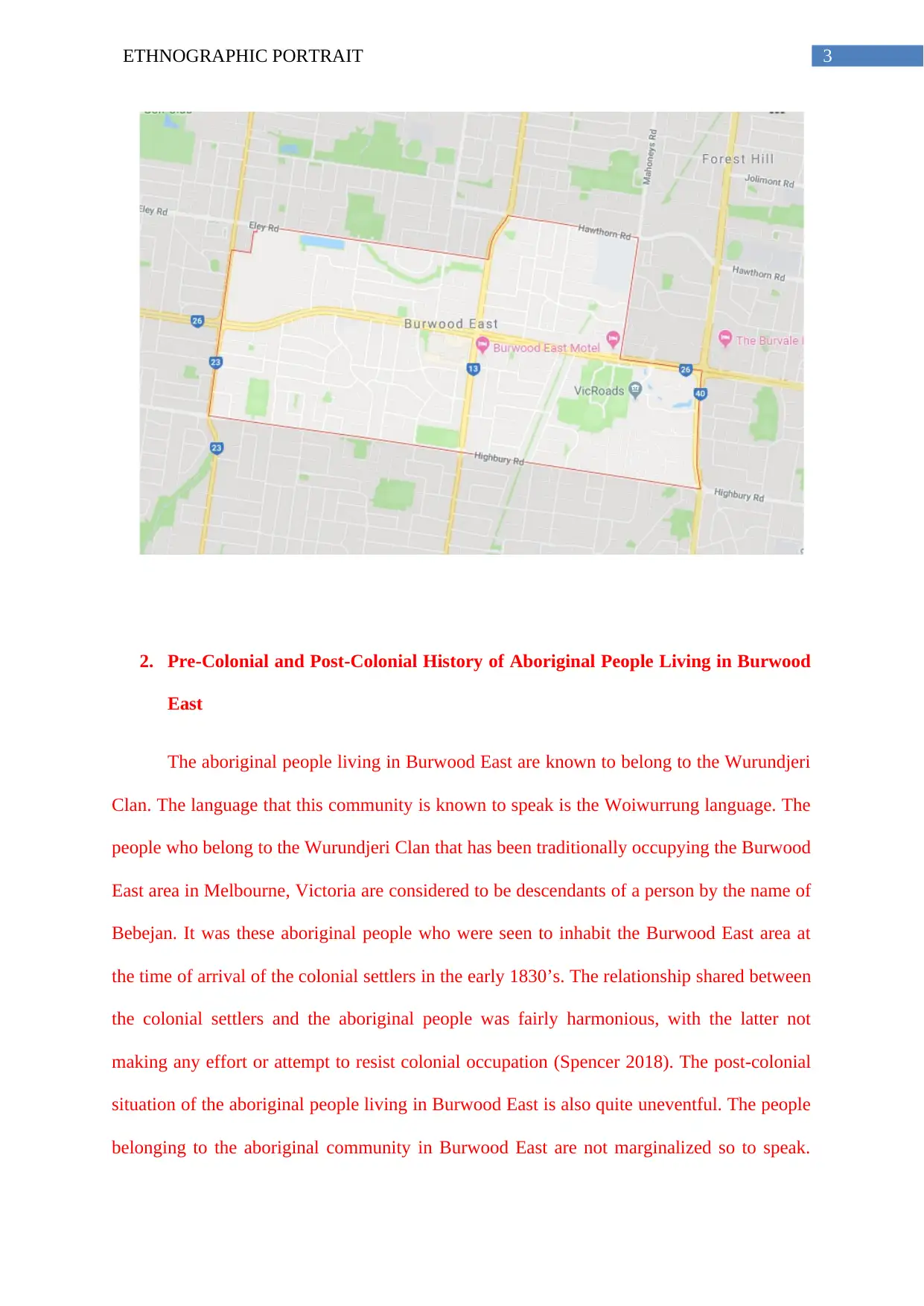
3ETHNOGRAPHIC PORTRAIT
2. Pre-Colonial and Post-Colonial History of Aboriginal People Living in Burwood
East
The aboriginal people living in Burwood East are known to belong to the Wurundjeri
Clan. The language that this community is known to speak is the Woiwurrung language. The
people who belong to the Wurundjeri Clan that has been traditionally occupying the Burwood
East area in Melbourne, Victoria are considered to be descendants of a person by the name of
Bebejan. It was these aboriginal people who were seen to inhabit the Burwood East area at
the time of arrival of the colonial settlers in the early 1830’s. The relationship shared between
the colonial settlers and the aboriginal people was fairly harmonious, with the latter not
making any effort or attempt to resist colonial occupation (Spencer 2018). The post-colonial
situation of the aboriginal people living in Burwood East is also quite uneventful. The people
belonging to the aboriginal community in Burwood East are not marginalized so to speak.
2. Pre-Colonial and Post-Colonial History of Aboriginal People Living in Burwood
East
The aboriginal people living in Burwood East are known to belong to the Wurundjeri
Clan. The language that this community is known to speak is the Woiwurrung language. The
people who belong to the Wurundjeri Clan that has been traditionally occupying the Burwood
East area in Melbourne, Victoria are considered to be descendants of a person by the name of
Bebejan. It was these aboriginal people who were seen to inhabit the Burwood East area at
the time of arrival of the colonial settlers in the early 1830’s. The relationship shared between
the colonial settlers and the aboriginal people was fairly harmonious, with the latter not
making any effort or attempt to resist colonial occupation (Spencer 2018). The post-colonial
situation of the aboriginal people living in Burwood East is also quite uneventful. The people
belonging to the aboriginal community in Burwood East are not marginalized so to speak.
Paraphrase This Document
Need a fresh take? Get an instant paraphrase of this document with our AI Paraphraser
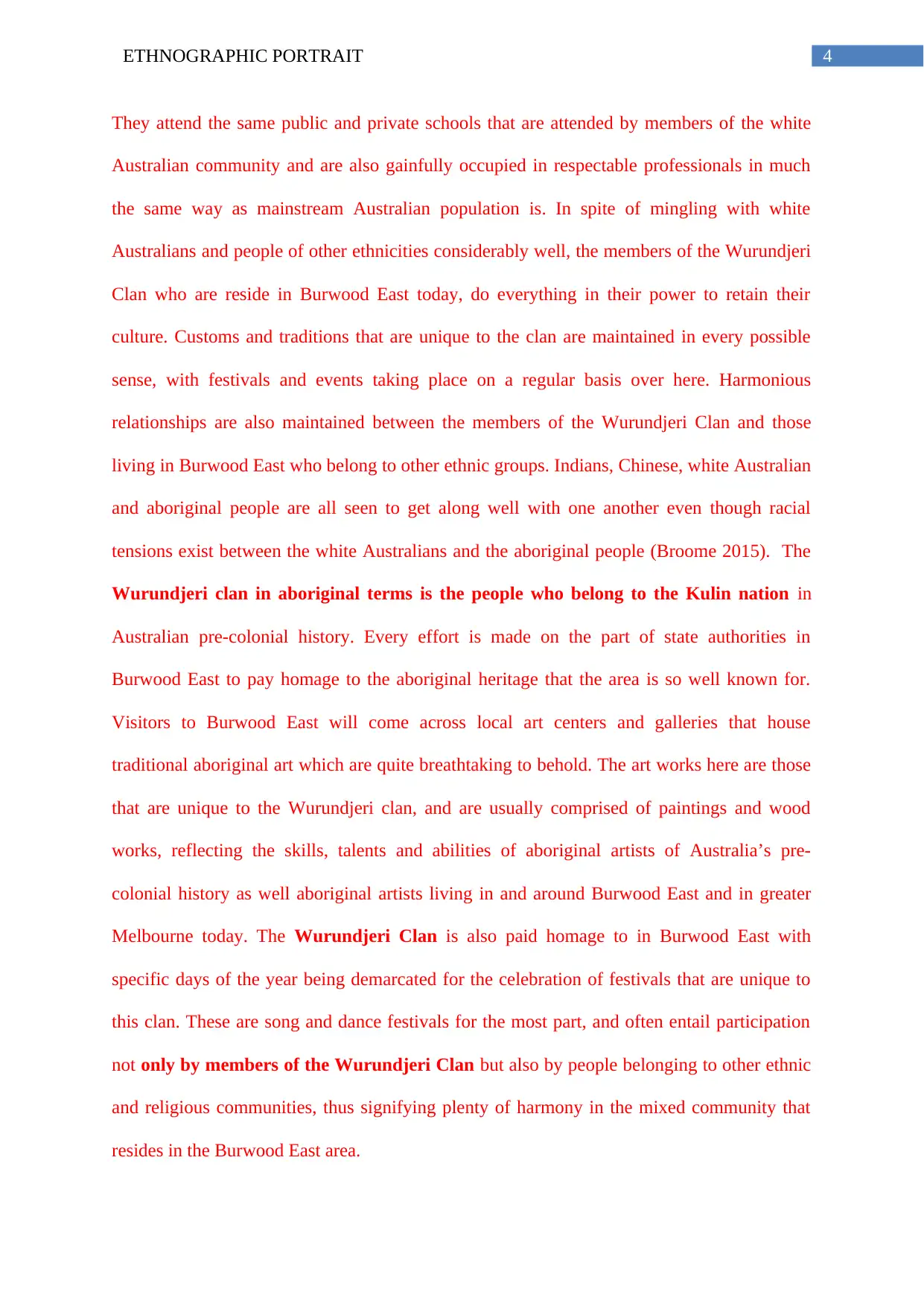
4ETHNOGRAPHIC PORTRAIT
They attend the same public and private schools that are attended by members of the white
Australian community and are also gainfully occupied in respectable professionals in much
the same way as mainstream Australian population is. In spite of mingling with white
Australians and people of other ethnicities considerably well, the members of the Wurundjeri
Clan who are reside in Burwood East today, do everything in their power to retain their
culture. Customs and traditions that are unique to the clan are maintained in every possible
sense, with festivals and events taking place on a regular basis over here. Harmonious
relationships are also maintained between the members of the Wurundjeri Clan and those
living in Burwood East who belong to other ethnic groups. Indians, Chinese, white Australian
and aboriginal people are all seen to get along well with one another even though racial
tensions exist between the white Australians and the aboriginal people (Broome 2015). The
Wurundjeri clan in aboriginal terms is the people who belong to the Kulin nation in
Australian pre-colonial history. Every effort is made on the part of state authorities in
Burwood East to pay homage to the aboriginal heritage that the area is so well known for.
Visitors to Burwood East will come across local art centers and galleries that house
traditional aboriginal art which are quite breathtaking to behold. The art works here are those
that are unique to the Wurundjeri clan, and are usually comprised of paintings and wood
works, reflecting the skills, talents and abilities of aboriginal artists of Australia’s pre-
colonial history as well aboriginal artists living in and around Burwood East and in greater
Melbourne today. The Wurundjeri Clan is also paid homage to in Burwood East with
specific days of the year being demarcated for the celebration of festivals that are unique to
this clan. These are song and dance festivals for the most part, and often entail participation
not only by members of the Wurundjeri Clan but also by people belonging to other ethnic
and religious communities, thus signifying plenty of harmony in the mixed community that
resides in the Burwood East area.
They attend the same public and private schools that are attended by members of the white
Australian community and are also gainfully occupied in respectable professionals in much
the same way as mainstream Australian population is. In spite of mingling with white
Australians and people of other ethnicities considerably well, the members of the Wurundjeri
Clan who are reside in Burwood East today, do everything in their power to retain their
culture. Customs and traditions that are unique to the clan are maintained in every possible
sense, with festivals and events taking place on a regular basis over here. Harmonious
relationships are also maintained between the members of the Wurundjeri Clan and those
living in Burwood East who belong to other ethnic groups. Indians, Chinese, white Australian
and aboriginal people are all seen to get along well with one another even though racial
tensions exist between the white Australians and the aboriginal people (Broome 2015). The
Wurundjeri clan in aboriginal terms is the people who belong to the Kulin nation in
Australian pre-colonial history. Every effort is made on the part of state authorities in
Burwood East to pay homage to the aboriginal heritage that the area is so well known for.
Visitors to Burwood East will come across local art centers and galleries that house
traditional aboriginal art which are quite breathtaking to behold. The art works here are those
that are unique to the Wurundjeri clan, and are usually comprised of paintings and wood
works, reflecting the skills, talents and abilities of aboriginal artists of Australia’s pre-
colonial history as well aboriginal artists living in and around Burwood East and in greater
Melbourne today. The Wurundjeri Clan is also paid homage to in Burwood East with
specific days of the year being demarcated for the celebration of festivals that are unique to
this clan. These are song and dance festivals for the most part, and often entail participation
not only by members of the Wurundjeri Clan but also by people belonging to other ethnic
and religious communities, thus signifying plenty of harmony in the mixed community that
resides in the Burwood East area.
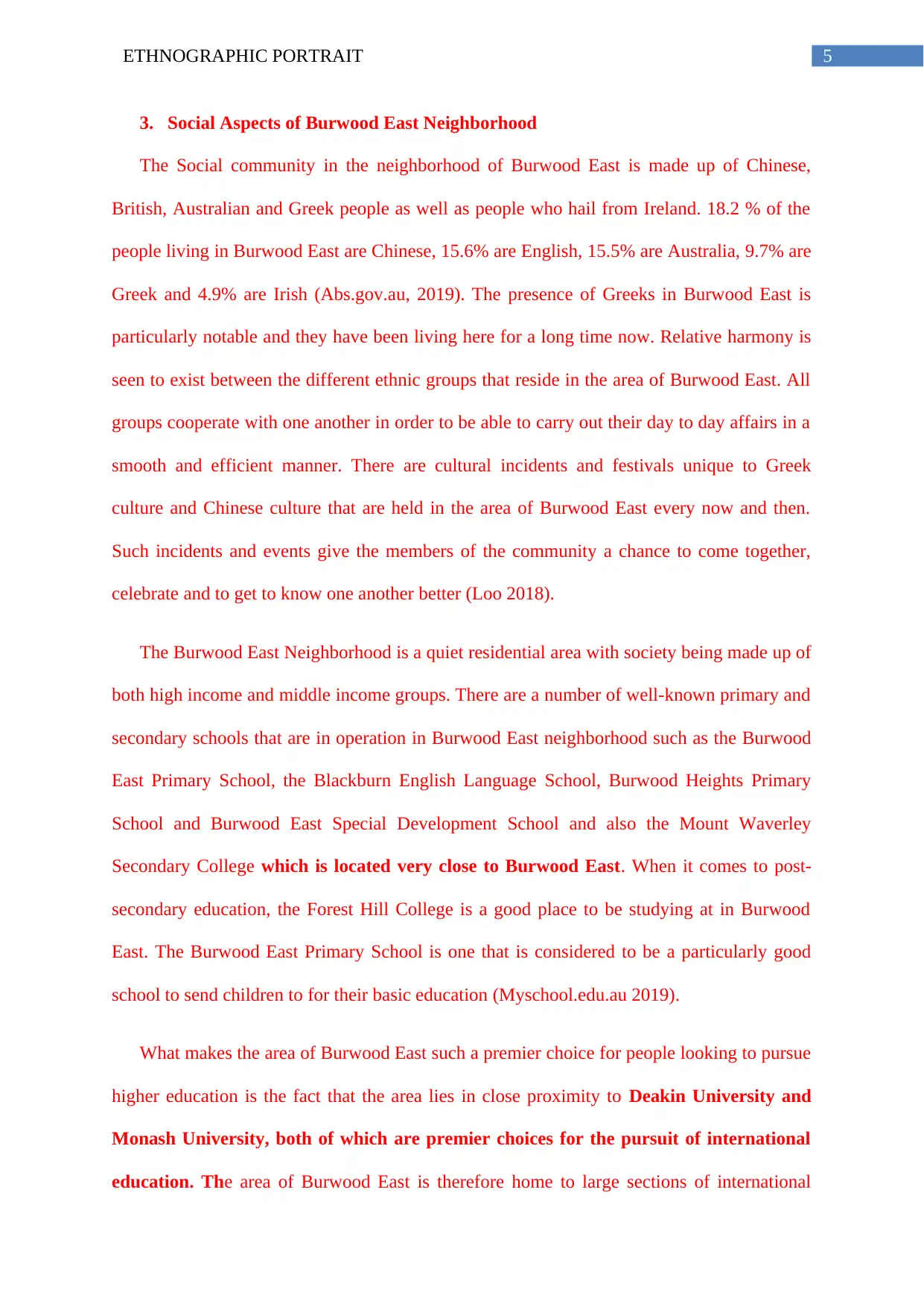
5ETHNOGRAPHIC PORTRAIT
3. Social Aspects of Burwood East Neighborhood
The Social community in the neighborhood of Burwood East is made up of Chinese,
British, Australian and Greek people as well as people who hail from Ireland. 18.2 % of the
people living in Burwood East are Chinese, 15.6% are English, 15.5% are Australia, 9.7% are
Greek and 4.9% are Irish (Abs.gov.au, 2019). The presence of Greeks in Burwood East is
particularly notable and they have been living here for a long time now. Relative harmony is
seen to exist between the different ethnic groups that reside in the area of Burwood East. All
groups cooperate with one another in order to be able to carry out their day to day affairs in a
smooth and efficient manner. There are cultural incidents and festivals unique to Greek
culture and Chinese culture that are held in the area of Burwood East every now and then.
Such incidents and events give the members of the community a chance to come together,
celebrate and to get to know one another better (Loo 2018).
The Burwood East Neighborhood is a quiet residential area with society being made up of
both high income and middle income groups. There are a number of well-known primary and
secondary schools that are in operation in Burwood East neighborhood such as the Burwood
East Primary School, the Blackburn English Language School, Burwood Heights Primary
School and Burwood East Special Development School and also the Mount Waverley
Secondary College which is located very close to Burwood East. When it comes to post-
secondary education, the Forest Hill College is a good place to be studying at in Burwood
East. The Burwood East Primary School is one that is considered to be a particularly good
school to send children to for their basic education (Myschool.edu.au 2019).
What makes the area of Burwood East such a premier choice for people looking to pursue
higher education is the fact that the area lies in close proximity to Deakin University and
Monash University, both of which are premier choices for the pursuit of international
education. The area of Burwood East is therefore home to large sections of international
3. Social Aspects of Burwood East Neighborhood
The Social community in the neighborhood of Burwood East is made up of Chinese,
British, Australian and Greek people as well as people who hail from Ireland. 18.2 % of the
people living in Burwood East are Chinese, 15.6% are English, 15.5% are Australia, 9.7% are
Greek and 4.9% are Irish (Abs.gov.au, 2019). The presence of Greeks in Burwood East is
particularly notable and they have been living here for a long time now. Relative harmony is
seen to exist between the different ethnic groups that reside in the area of Burwood East. All
groups cooperate with one another in order to be able to carry out their day to day affairs in a
smooth and efficient manner. There are cultural incidents and festivals unique to Greek
culture and Chinese culture that are held in the area of Burwood East every now and then.
Such incidents and events give the members of the community a chance to come together,
celebrate and to get to know one another better (Loo 2018).
The Burwood East Neighborhood is a quiet residential area with society being made up of
both high income and middle income groups. There are a number of well-known primary and
secondary schools that are in operation in Burwood East neighborhood such as the Burwood
East Primary School, the Blackburn English Language School, Burwood Heights Primary
School and Burwood East Special Development School and also the Mount Waverley
Secondary College which is located very close to Burwood East. When it comes to post-
secondary education, the Forest Hill College is a good place to be studying at in Burwood
East. The Burwood East Primary School is one that is considered to be a particularly good
school to send children to for their basic education (Myschool.edu.au 2019).
What makes the area of Burwood East such a premier choice for people looking to pursue
higher education is the fact that the area lies in close proximity to Deakin University and
Monash University, both of which are premier choices for the pursuit of international
education. The area of Burwood East is therefore home to large sections of international
⊘ This is a preview!⊘
Do you want full access?
Subscribe today to unlock all pages.

Trusted by 1+ million students worldwide
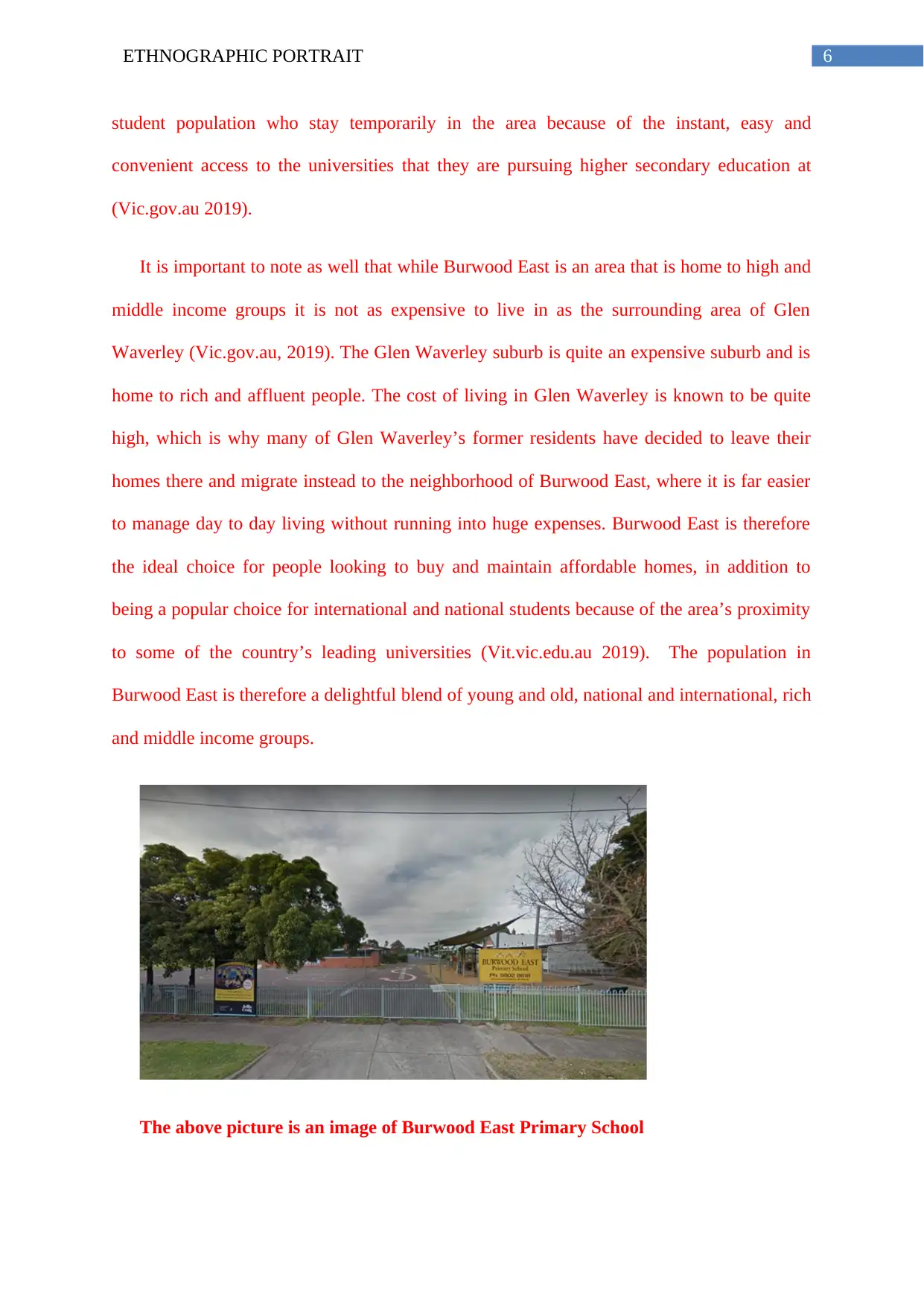
6ETHNOGRAPHIC PORTRAIT
student population who stay temporarily in the area because of the instant, easy and
convenient access to the universities that they are pursuing higher secondary education at
(Vic.gov.au 2019).
It is important to note as well that while Burwood East is an area that is home to high and
middle income groups it is not as expensive to live in as the surrounding area of Glen
Waverley (Vic.gov.au, 2019). The Glen Waverley suburb is quite an expensive suburb and is
home to rich and affluent people. The cost of living in Glen Waverley is known to be quite
high, which is why many of Glen Waverley’s former residents have decided to leave their
homes there and migrate instead to the neighborhood of Burwood East, where it is far easier
to manage day to day living without running into huge expenses. Burwood East is therefore
the ideal choice for people looking to buy and maintain affordable homes, in addition to
being a popular choice for international and national students because of the area’s proximity
to some of the country’s leading universities (Vit.vic.edu.au 2019). The population in
Burwood East is therefore a delightful blend of young and old, national and international, rich
and middle income groups.
The above picture is an image of Burwood East Primary School
student population who stay temporarily in the area because of the instant, easy and
convenient access to the universities that they are pursuing higher secondary education at
(Vic.gov.au 2019).
It is important to note as well that while Burwood East is an area that is home to high and
middle income groups it is not as expensive to live in as the surrounding area of Glen
Waverley (Vic.gov.au, 2019). The Glen Waverley suburb is quite an expensive suburb and is
home to rich and affluent people. The cost of living in Glen Waverley is known to be quite
high, which is why many of Glen Waverley’s former residents have decided to leave their
homes there and migrate instead to the neighborhood of Burwood East, where it is far easier
to manage day to day living without running into huge expenses. Burwood East is therefore
the ideal choice for people looking to buy and maintain affordable homes, in addition to
being a popular choice for international and national students because of the area’s proximity
to some of the country’s leading universities (Vit.vic.edu.au 2019). The population in
Burwood East is therefore a delightful blend of young and old, national and international, rich
and middle income groups.
The above picture is an image of Burwood East Primary School
Paraphrase This Document
Need a fresh take? Get an instant paraphrase of this document with our AI Paraphraser
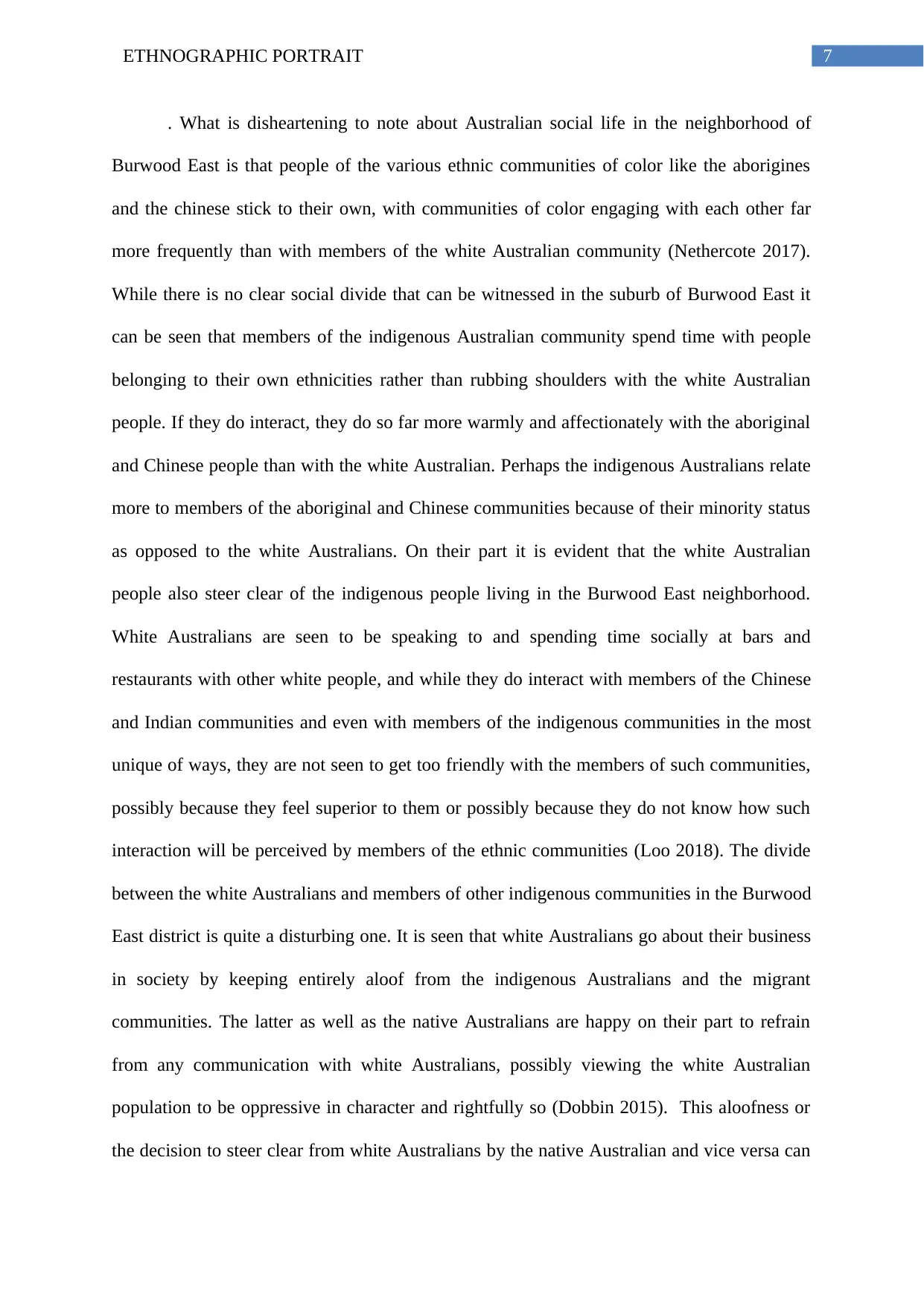
7ETHNOGRAPHIC PORTRAIT
. What is disheartening to note about Australian social life in the neighborhood of
Burwood East is that people of the various ethnic communities of color like the aborigines
and the chinese stick to their own, with communities of color engaging with each other far
more frequently than with members of the white Australian community (Nethercote 2017).
While there is no clear social divide that can be witnessed in the suburb of Burwood East it
can be seen that members of the indigenous Australian community spend time with people
belonging to their own ethnicities rather than rubbing shoulders with the white Australian
people. If they do interact, they do so far more warmly and affectionately with the aboriginal
and Chinese people than with the white Australian. Perhaps the indigenous Australians relate
more to members of the aboriginal and Chinese communities because of their minority status
as opposed to the white Australians. On their part it is evident that the white Australian
people also steer clear of the indigenous people living in the Burwood East neighborhood.
White Australians are seen to be speaking to and spending time socially at bars and
restaurants with other white people, and while they do interact with members of the Chinese
and Indian communities and even with members of the indigenous communities in the most
unique of ways, they are not seen to get too friendly with the members of such communities,
possibly because they feel superior to them or possibly because they do not know how such
interaction will be perceived by members of the ethnic communities (Loo 2018). The divide
between the white Australians and members of other indigenous communities in the Burwood
East district is quite a disturbing one. It is seen that white Australians go about their business
in society by keeping entirely aloof from the indigenous Australians and the migrant
communities. The latter as well as the native Australians are happy on their part to refrain
from any communication with white Australians, possibly viewing the white Australian
population to be oppressive in character and rightfully so (Dobbin 2015). This aloofness or
the decision to steer clear from white Australians by the native Australian and vice versa can
. What is disheartening to note about Australian social life in the neighborhood of
Burwood East is that people of the various ethnic communities of color like the aborigines
and the chinese stick to their own, with communities of color engaging with each other far
more frequently than with members of the white Australian community (Nethercote 2017).
While there is no clear social divide that can be witnessed in the suburb of Burwood East it
can be seen that members of the indigenous Australian community spend time with people
belonging to their own ethnicities rather than rubbing shoulders with the white Australian
people. If they do interact, they do so far more warmly and affectionately with the aboriginal
and Chinese people than with the white Australian. Perhaps the indigenous Australians relate
more to members of the aboriginal and Chinese communities because of their minority status
as opposed to the white Australians. On their part it is evident that the white Australian
people also steer clear of the indigenous people living in the Burwood East neighborhood.
White Australians are seen to be speaking to and spending time socially at bars and
restaurants with other white people, and while they do interact with members of the Chinese
and Indian communities and even with members of the indigenous communities in the most
unique of ways, they are not seen to get too friendly with the members of such communities,
possibly because they feel superior to them or possibly because they do not know how such
interaction will be perceived by members of the ethnic communities (Loo 2018). The divide
between the white Australians and members of other indigenous communities in the Burwood
East district is quite a disturbing one. It is seen that white Australians go about their business
in society by keeping entirely aloof from the indigenous Australians and the migrant
communities. The latter as well as the native Australians are happy on their part to refrain
from any communication with white Australians, possibly viewing the white Australian
population to be oppressive in character and rightfully so (Dobbin 2015). This aloofness or
the decision to steer clear from white Australians by the native Australian and vice versa can
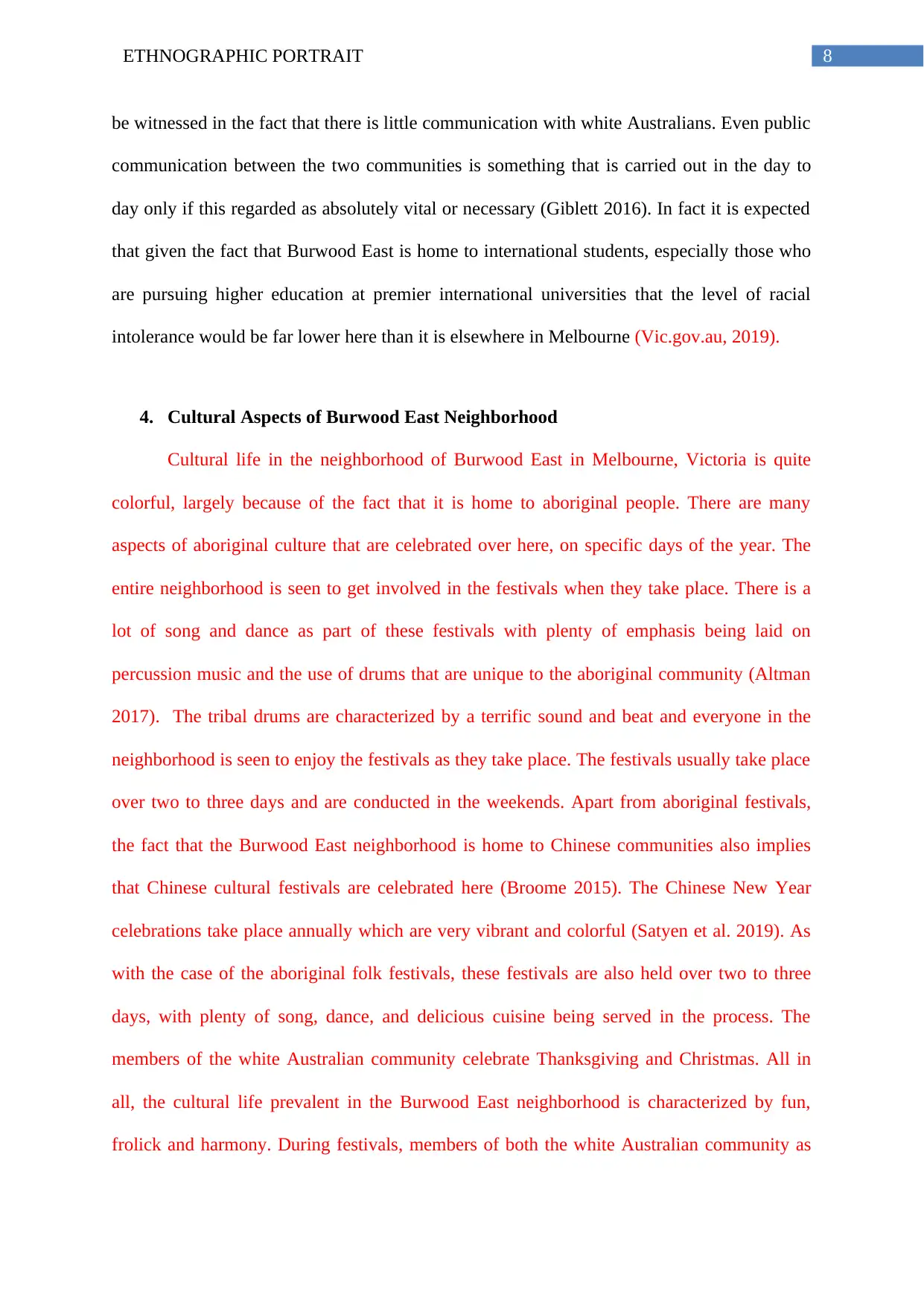
8ETHNOGRAPHIC PORTRAIT
be witnessed in the fact that there is little communication with white Australians. Even public
communication between the two communities is something that is carried out in the day to
day only if this regarded as absolutely vital or necessary (Giblett 2016). In fact it is expected
that given the fact that Burwood East is home to international students, especially those who
are pursuing higher education at premier international universities that the level of racial
intolerance would be far lower here than it is elsewhere in Melbourne (Vic.gov.au, 2019).
4. Cultural Aspects of Burwood East Neighborhood
Cultural life in the neighborhood of Burwood East in Melbourne, Victoria is quite
colorful, largely because of the fact that it is home to aboriginal people. There are many
aspects of aboriginal culture that are celebrated over here, on specific days of the year. The
entire neighborhood is seen to get involved in the festivals when they take place. There is a
lot of song and dance as part of these festivals with plenty of emphasis being laid on
percussion music and the use of drums that are unique to the aboriginal community (Altman
2017). The tribal drums are characterized by a terrific sound and beat and everyone in the
neighborhood is seen to enjoy the festivals as they take place. The festivals usually take place
over two to three days and are conducted in the weekends. Apart from aboriginal festivals,
the fact that the Burwood East neighborhood is home to Chinese communities also implies
that Chinese cultural festivals are celebrated here (Broome 2015). The Chinese New Year
celebrations take place annually which are very vibrant and colorful (Satyen et al. 2019). As
with the case of the aboriginal folk festivals, these festivals are also held over two to three
days, with plenty of song, dance, and delicious cuisine being served in the process. The
members of the white Australian community celebrate Thanksgiving and Christmas. All in
all, the cultural life prevalent in the Burwood East neighborhood is characterized by fun,
frolick and harmony. During festivals, members of both the white Australian community as
be witnessed in the fact that there is little communication with white Australians. Even public
communication between the two communities is something that is carried out in the day to
day only if this regarded as absolutely vital or necessary (Giblett 2016). In fact it is expected
that given the fact that Burwood East is home to international students, especially those who
are pursuing higher education at premier international universities that the level of racial
intolerance would be far lower here than it is elsewhere in Melbourne (Vic.gov.au, 2019).
4. Cultural Aspects of Burwood East Neighborhood
Cultural life in the neighborhood of Burwood East in Melbourne, Victoria is quite
colorful, largely because of the fact that it is home to aboriginal people. There are many
aspects of aboriginal culture that are celebrated over here, on specific days of the year. The
entire neighborhood is seen to get involved in the festivals when they take place. There is a
lot of song and dance as part of these festivals with plenty of emphasis being laid on
percussion music and the use of drums that are unique to the aboriginal community (Altman
2017). The tribal drums are characterized by a terrific sound and beat and everyone in the
neighborhood is seen to enjoy the festivals as they take place. The festivals usually take place
over two to three days and are conducted in the weekends. Apart from aboriginal festivals,
the fact that the Burwood East neighborhood is home to Chinese communities also implies
that Chinese cultural festivals are celebrated here (Broome 2015). The Chinese New Year
celebrations take place annually which are very vibrant and colorful (Satyen et al. 2019). As
with the case of the aboriginal folk festivals, these festivals are also held over two to three
days, with plenty of song, dance, and delicious cuisine being served in the process. The
members of the white Australian community celebrate Thanksgiving and Christmas. All in
all, the cultural life prevalent in the Burwood East neighborhood is characterized by fun,
frolick and harmony. During festivals, members of both the white Australian community as
⊘ This is a preview!⊘
Do you want full access?
Subscribe today to unlock all pages.

Trusted by 1+ million students worldwide
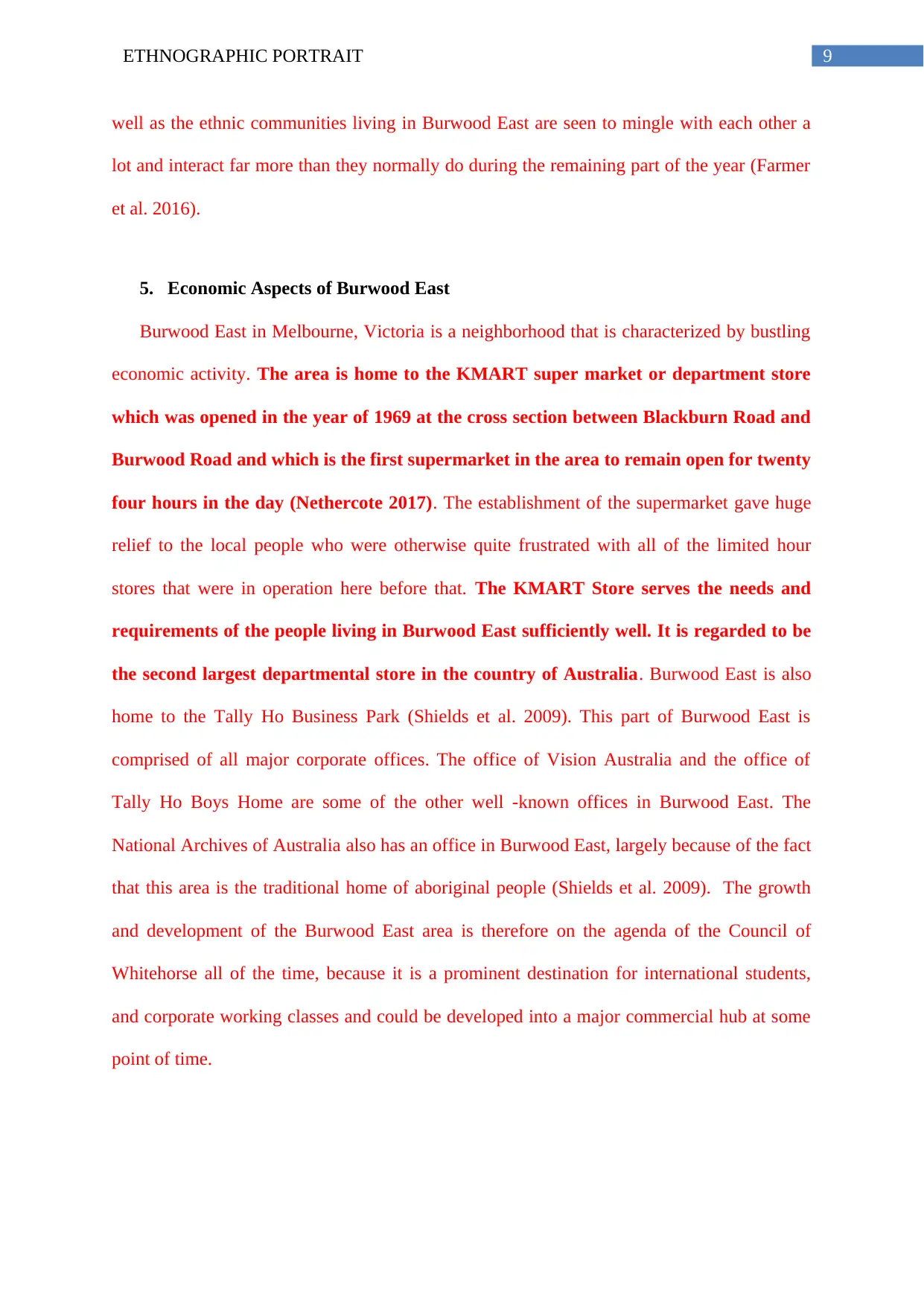
9ETHNOGRAPHIC PORTRAIT
well as the ethnic communities living in Burwood East are seen to mingle with each other a
lot and interact far more than they normally do during the remaining part of the year (Farmer
et al. 2016).
5. Economic Aspects of Burwood East
Burwood East in Melbourne, Victoria is a neighborhood that is characterized by bustling
economic activity. The area is home to the KMART super market or department store
which was opened in the year of 1969 at the cross section between Blackburn Road and
Burwood Road and which is the first supermarket in the area to remain open for twenty
four hours in the day (Nethercote 2017). The establishment of the supermarket gave huge
relief to the local people who were otherwise quite frustrated with all of the limited hour
stores that were in operation here before that. The KMART Store serves the needs and
requirements of the people living in Burwood East sufficiently well. It is regarded to be
the second largest departmental store in the country of Australia. Burwood East is also
home to the Tally Ho Business Park (Shields et al. 2009). This part of Burwood East is
comprised of all major corporate offices. The office of Vision Australia and the office of
Tally Ho Boys Home are some of the other well -known offices in Burwood East. The
National Archives of Australia also has an office in Burwood East, largely because of the fact
that this area is the traditional home of aboriginal people (Shields et al. 2009). The growth
and development of the Burwood East area is therefore on the agenda of the Council of
Whitehorse all of the time, because it is a prominent destination for international students,
and corporate working classes and could be developed into a major commercial hub at some
point of time.
well as the ethnic communities living in Burwood East are seen to mingle with each other a
lot and interact far more than they normally do during the remaining part of the year (Farmer
et al. 2016).
5. Economic Aspects of Burwood East
Burwood East in Melbourne, Victoria is a neighborhood that is characterized by bustling
economic activity. The area is home to the KMART super market or department store
which was opened in the year of 1969 at the cross section between Blackburn Road and
Burwood Road and which is the first supermarket in the area to remain open for twenty
four hours in the day (Nethercote 2017). The establishment of the supermarket gave huge
relief to the local people who were otherwise quite frustrated with all of the limited hour
stores that were in operation here before that. The KMART Store serves the needs and
requirements of the people living in Burwood East sufficiently well. It is regarded to be
the second largest departmental store in the country of Australia. Burwood East is also
home to the Tally Ho Business Park (Shields et al. 2009). This part of Burwood East is
comprised of all major corporate offices. The office of Vision Australia and the office of
Tally Ho Boys Home are some of the other well -known offices in Burwood East. The
National Archives of Australia also has an office in Burwood East, largely because of the fact
that this area is the traditional home of aboriginal people (Shields et al. 2009). The growth
and development of the Burwood East area is therefore on the agenda of the Council of
Whitehorse all of the time, because it is a prominent destination for international students,
and corporate working classes and could be developed into a major commercial hub at some
point of time.
Paraphrase This Document
Need a fresh take? Get an instant paraphrase of this document with our AI Paraphraser
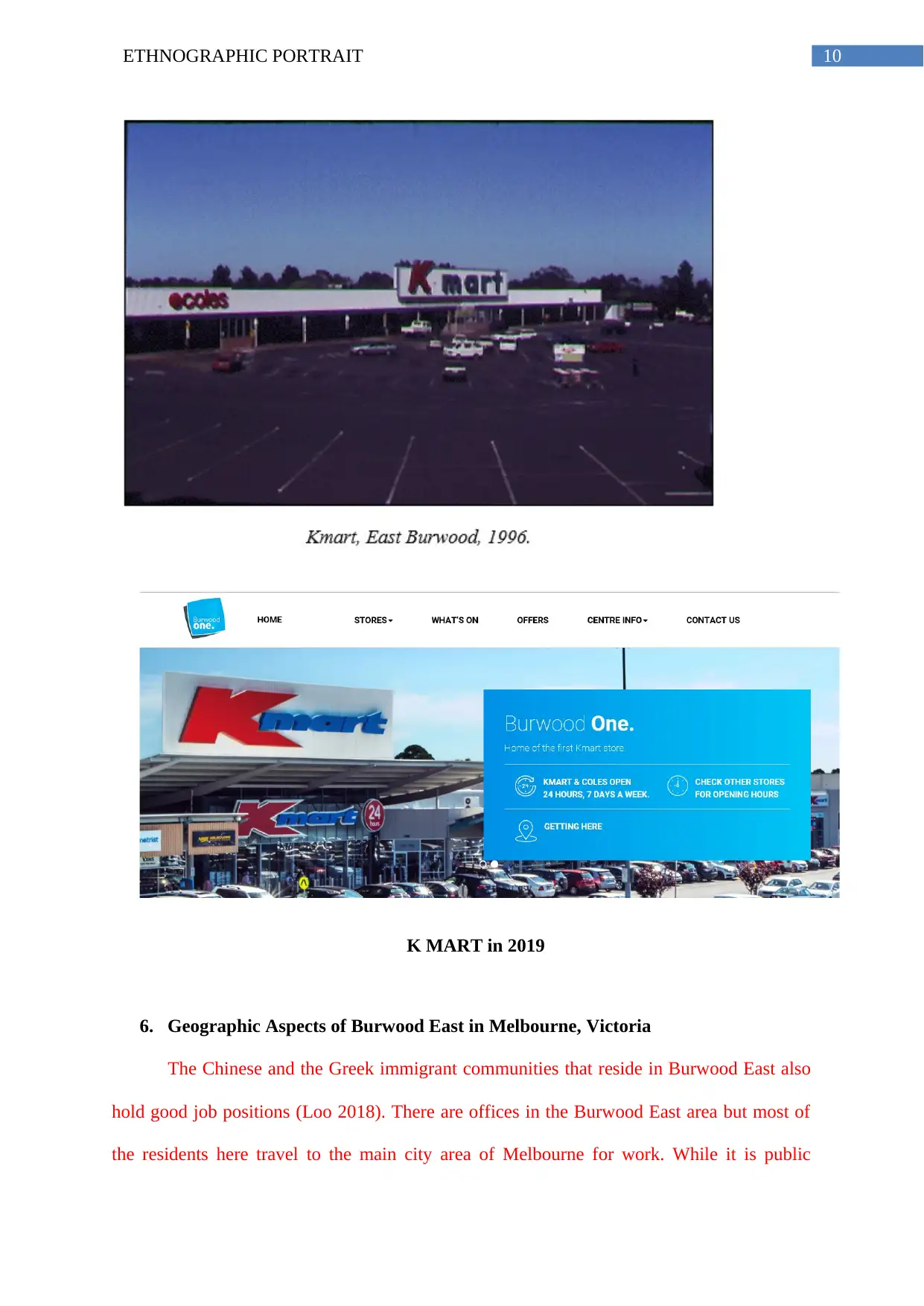
10ETHNOGRAPHIC PORTRAIT
K MART in 2019
6. Geographic Aspects of Burwood East in Melbourne, Victoria
The Chinese and the Greek immigrant communities that reside in Burwood East also
hold good job positions (Loo 2018). There are offices in the Burwood East area but most of
the residents here travel to the main city area of Melbourne for work. While it is public
K MART in 2019
6. Geographic Aspects of Burwood East in Melbourne, Victoria
The Chinese and the Greek immigrant communities that reside in Burwood East also
hold good job positions (Loo 2018). There are offices in the Burwood East area but most of
the residents here travel to the main city area of Melbourne for work. While it is public
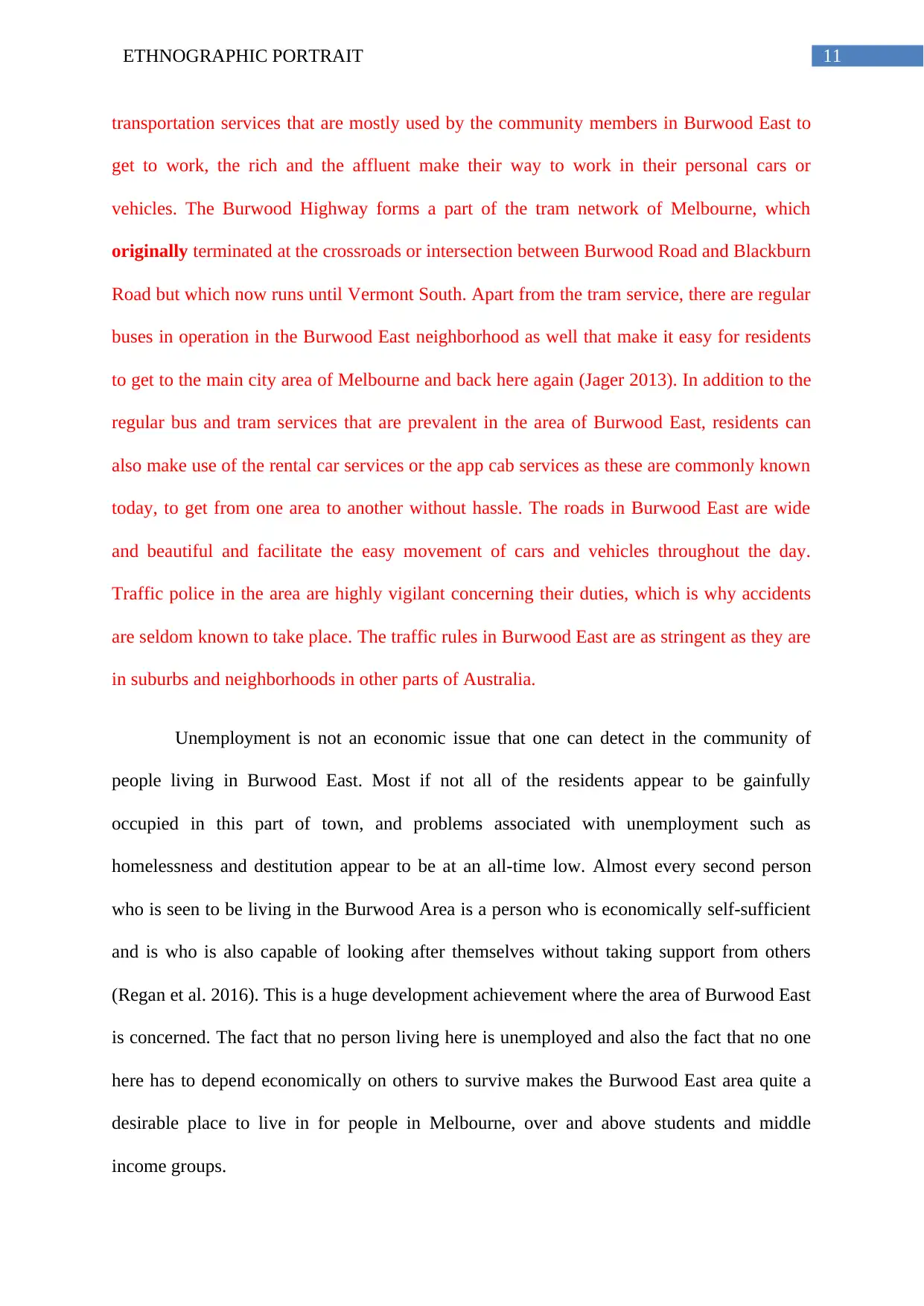
11ETHNOGRAPHIC PORTRAIT
transportation services that are mostly used by the community members in Burwood East to
get to work, the rich and the affluent make their way to work in their personal cars or
vehicles. The Burwood Highway forms a part of the tram network of Melbourne, which
originally terminated at the crossroads or intersection between Burwood Road and Blackburn
Road but which now runs until Vermont South. Apart from the tram service, there are regular
buses in operation in the Burwood East neighborhood as well that make it easy for residents
to get to the main city area of Melbourne and back here again (Jager 2013). In addition to the
regular bus and tram services that are prevalent in the area of Burwood East, residents can
also make use of the rental car services or the app cab services as these are commonly known
today, to get from one area to another without hassle. The roads in Burwood East are wide
and beautiful and facilitate the easy movement of cars and vehicles throughout the day.
Traffic police in the area are highly vigilant concerning their duties, which is why accidents
are seldom known to take place. The traffic rules in Burwood East are as stringent as they are
in suburbs and neighborhoods in other parts of Australia.
Unemployment is not an economic issue that one can detect in the community of
people living in Burwood East. Most if not all of the residents appear to be gainfully
occupied in this part of town, and problems associated with unemployment such as
homelessness and destitution appear to be at an all-time low. Almost every second person
who is seen to be living in the Burwood Area is a person who is economically self-sufficient
and is who is also capable of looking after themselves without taking support from others
(Regan et al. 2016). This is a huge development achievement where the area of Burwood East
is concerned. The fact that no person living here is unemployed and also the fact that no one
here has to depend economically on others to survive makes the Burwood East area quite a
desirable place to live in for people in Melbourne, over and above students and middle
income groups.
transportation services that are mostly used by the community members in Burwood East to
get to work, the rich and the affluent make their way to work in their personal cars or
vehicles. The Burwood Highway forms a part of the tram network of Melbourne, which
originally terminated at the crossroads or intersection between Burwood Road and Blackburn
Road but which now runs until Vermont South. Apart from the tram service, there are regular
buses in operation in the Burwood East neighborhood as well that make it easy for residents
to get to the main city area of Melbourne and back here again (Jager 2013). In addition to the
regular bus and tram services that are prevalent in the area of Burwood East, residents can
also make use of the rental car services or the app cab services as these are commonly known
today, to get from one area to another without hassle. The roads in Burwood East are wide
and beautiful and facilitate the easy movement of cars and vehicles throughout the day.
Traffic police in the area are highly vigilant concerning their duties, which is why accidents
are seldom known to take place. The traffic rules in Burwood East are as stringent as they are
in suburbs and neighborhoods in other parts of Australia.
Unemployment is not an economic issue that one can detect in the community of
people living in Burwood East. Most if not all of the residents appear to be gainfully
occupied in this part of town, and problems associated with unemployment such as
homelessness and destitution appear to be at an all-time low. Almost every second person
who is seen to be living in the Burwood Area is a person who is economically self-sufficient
and is who is also capable of looking after themselves without taking support from others
(Regan et al. 2016). This is a huge development achievement where the area of Burwood East
is concerned. The fact that no person living here is unemployed and also the fact that no one
here has to depend economically on others to survive makes the Burwood East area quite a
desirable place to live in for people in Melbourne, over and above students and middle
income groups.
⊘ This is a preview!⊘
Do you want full access?
Subscribe today to unlock all pages.

Trusted by 1+ million students worldwide
1 out of 16
Your All-in-One AI-Powered Toolkit for Academic Success.
+13062052269
info@desklib.com
Available 24*7 on WhatsApp / Email
![[object Object]](/_next/static/media/star-bottom.7253800d.svg)
Unlock your academic potential
Copyright © 2020–2025 A2Z Services. All Rights Reserved. Developed and managed by ZUCOL.